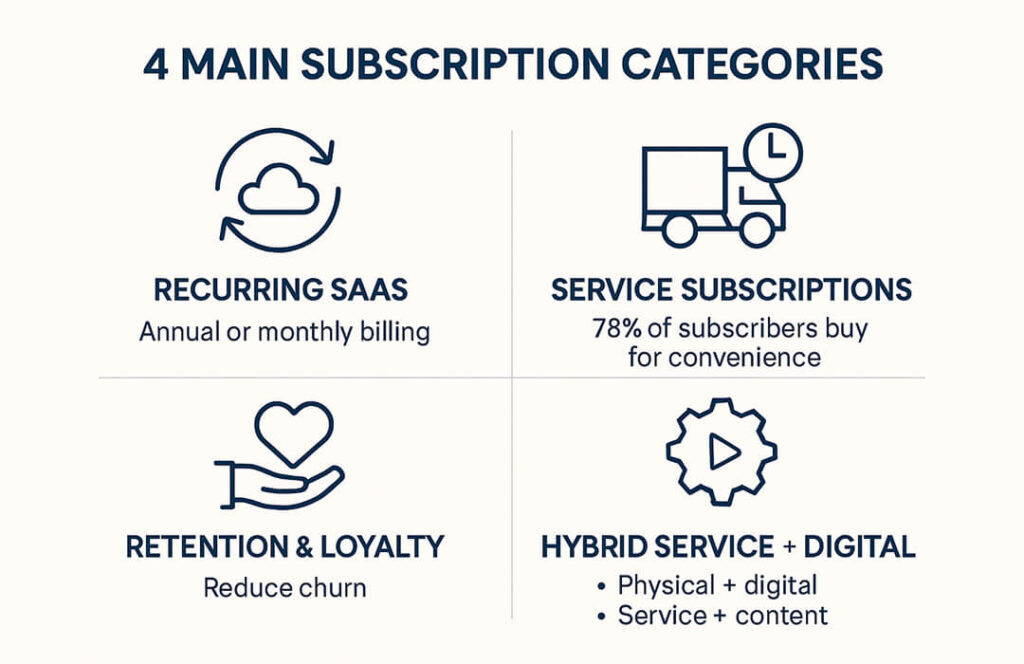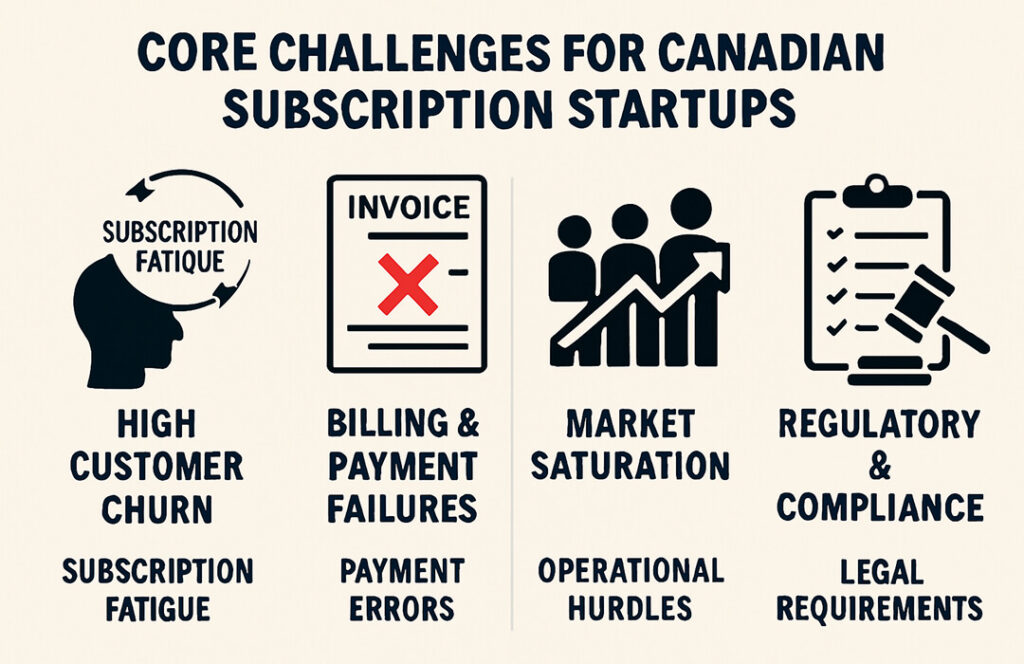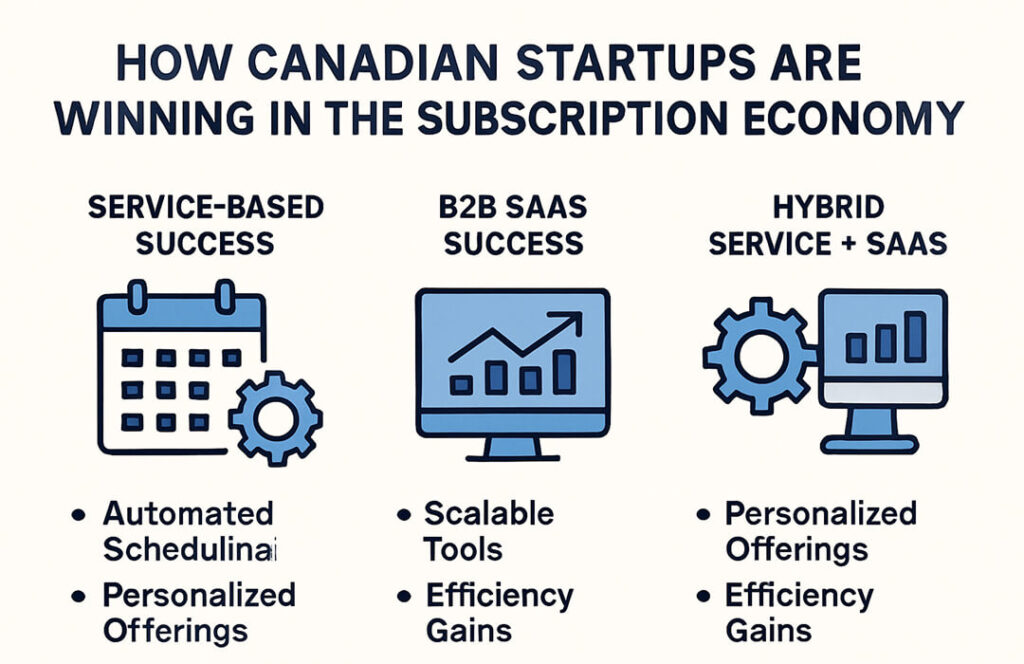The subscription economy in Canada isn’t just a global trend; it’s becoming a powerful force in Canada’s business landscape. In fact, the Canadian subscription services market, including subscription boxes, SaaS, and digital plans, was valued at nearly USD 750 million in 2024 and is projected to soar past USD 4 billion by 2033, growing at an impressive 18.4% CAGR.
For startups, this shift opens up a world of opportunity. Unlike traditional sales, where revenue depends on one-off purchases, subscriptions create predictable, recurring income. They also help businesses build stronger customer relationships, boost loyalty, and scale faster thanks to digital adoption and recurring payment solutions that simplify billing and compliance.
But the path isn’t without challenges. Startups entering this space often struggle with high churn rates, intense competition, and what experts call “subscription fatigue,” a phenomenon where consumers feel overwhelmed by too many recurring payments.
That’s why understanding this market is so important. In this blog, we’ll explore what Canadians are subscribing to, why this economy is booming, and how startups can tackle these challenges to build profitable, future-ready businesses.
Top Canadian Subscription Services: What People Subscribe to in 2025

Canada’s subscription box business Canada is expanding quickly, with consumers adopting services that save time, simplify operations, and add value. According to a 2024 survey, the average Canadian maintains about 8 recurring subscriptions, highlighting how integrated these services have become in daily life.
Many Canadians also struggle to manage multiple subscriptions efficiently: 73% signed up for free trials or promotions and forgot to cancel, and 66% paid for services they didn’t realize were still active. This creates opportunities for SaaS subscription startups offering streamlined subscription solutions, like those provided through platforms such as Clarro.
Here are the categories of subscriptions reflecting real Canadian business needs:
1. Recurring Business Tools & SaaS
Startups and small businesses rely on cloud-based SaaS platforms for managing tasks such as subscription billing, scheduling, and workforce management. Tools that automate these processes save time, reduce errors, and improve customer satisfaction.
2. Service Subscriptions
Many Canadians subscribe to regular service-based offerings, from cleaning and maintenance to wellness and personal care. Platforms that manage recurring bookings and payments help businesses deliver consistent service while keeping subscribers engaged.
3. Retention & Loyalty Solutions
Businesses are increasingly subscribing to loyalty programs, automated engagement tools, and personalized management platforms. These solutions enhance customer experience, minimize churn, and boost lifetime value.
4. Hybrid Service + Digital Subscriptions
Some companies combine physical services with online tools, for example, subscription-based wellness programs with app-based scheduling or coaching. This hybrid approach provides convenience, personalization, and measurable value for subscribers.
Explore more SaaS solutions for Canadian businesses: 10 Best SaaS Marketplaces That Developers Prefer in 2025
What’s Driving the Boom in Canada’s Subscription Economy
Canada’s subscription economy is experiencing rapid growth, driven by several key factors that resonate with Canadian consumers:
1. Convenience First
Consumers increasingly value time savings and hassle-free delivery. Subscription services offer the convenience of having products delivered directly to their doorstep, eliminating the need for frequent trips to stores. This convenience aligns with the fast-paced lifestyles of many Canadians.
2. Personalization
Tailored experiences are a significant driver of adoption. Subscription services that offer personalized selections based on individual preferences enhance customer satisfaction and loyalty. By leveraging data analytics, businesses can curate offerings that meet the unique needs of their subscribers.
3. Eco-Conscious & Local-First Preferences
Approximately 30% of Canadians prioritize sustainability when choosing subscription services. Additionally, 60% prefer supporting Canadian businesses, reflecting a strong inclination towards eco-friendly practices and local enterprises. This trend underscores the importance of sustainability and local support in consumer decision-making.
4. Digital Adoption
Canada’s digital subscription services in Canada are growing rapidly, driven by personalization, eco-conscious preferences, and technology adoption. The rise of SaaS and e-commerce platforms has made recurring revenue models more accessible than ever. These digital tools enable businesses to efficiently manage subscriptions, streamline operations, and offer seamless customer experiences. The integration of technology has been pivotal in the expansion of the subscription economy in Canada.
At the same time, Subscription management software Canada is helping startups reduce churn, improve billing accuracy, and maintain compliance. By combining automation with analytics, founders can make data-driven decisions and build sustainable business models.

The Core Challenges Canadian Startups Face in the Subscription Economy
While Canada’s subscription economy is thriving, startups often encounter significant obstacles that can hinder growth and sustainability. Addressing these challenges proactively is crucial for long-term success.
High Customer Churn
Customer churn remains a critical issue for subscription-based businesses. Factors contributing to high churn rates include:
- Perceived Lack of Value: If customers feel they’re not receiving sufficient value, they may cancel their subscriptions.
- Subscription Fatigue: With an increasing number of subscriptions, consumers may opt to reduce their commitments to manage expenses.
- Involuntary Churn: Issues like expired credit cards or payment failures can lead to unintentional cancellations, affecting revenue streams.
Implementing strategies such as personalized offerings, loyalty programs, and proactive customer engagement can help mitigate churn.
Billing & Payment Failures
Billing and payment issues can significantly impact a startup’s revenue and customer trust. Common challenges include failed renewals, compliance, and customer friction. Using tools like subscription billing automation, startups can cut down payment failures by up to 30% and create a smoother billing experience for subscribers.
- Failed Renewals: Technical glitches or outdated payment information can result in failed transactions.
- Complex Compliance: Navigating the intricacies of Canadian tax laws and payment regulations can be daunting for startups.
- Customer Friction: Misunderstandings related to billing cycles or charges can lead to dissatisfaction.
Using tools like Clarro for subscription management and automated billing can help startups streamline payments and reduce errors.
Market Saturation
Certain subscription sectors, such as meal kits and streaming services, are becoming increasingly competitive. To stand out in a crowded market:
- Differentiate Offerings: Provide unique value propositions that set your service apart.
- Target Niche Audiences: Focus on specific customer segments to cater to their unique needs.
- Innovate Continuously: Regularly update and improve your offerings to stay relevant.
Understanding market trends and consumer preferences is essential for navigating saturation.
Scaling Challenges
Transitioning from a small to a large customer base presents several hurdles:
- Operational Efficiency: Scaling operations without compromising service quality can be challenging.
- Customer Support: Maintaining personalized support as the subscriber base grows requires strategic planning.
- Infrastructure: Ensuring that technological systems can handle increased demand is crucial.
Investing in scalable systems and processes can facilitate smooth growth.
Regulatory & Compliance
Operating within Canada’s legal frameworks involves:
- Consumer Protection Laws: Adhering to laws that safeguard consumer rights.
- Privacy Regulations: Complying with data protection rules to maintain customer trust.
- Payment Compliance: Understanding and implementing the necessary payment regulations.
Staying informed about regulatory changes and seeking legal counsel can help navigate this complex landscape.
Opportunities for Canadian Startups in the Subscription Economy
Canada’s subscription market is evolving rapidly, presenting unique opportunities for startups to tap into emerging niches and consumer preferences. By aligning offerings with current trends, businesses can position themselves for sustained growth and customer loyalty.
1. Hyper-Niche Markets
Startups can cater to specialized customer interests by offering tailored subscription services:
- Service-Based Subscriptions: Businesses like cleaning, wellness, or personal care services can manage recurring appointments and bookings efficiently.
- Local & Regional Products: Subscription boxes featuring Canadian-made goods, snacks, eco-friendly household items, or artisan products appeal to consumers who want local-first options.
- Personal Care & Beauty Services: Recurring grooming or beauty service appointments provide convenience and predictability for busy consumers.
2. Eco-Friendly & Sustainable Subscriptions
Sustainability is a growing priority in Canada:
- Green Packaging & Products: Recurring services can adopt eco-friendly practices, such as paperless invoicing or reusable containers.
- Local Sourcing: Supporting Canadian suppliers reduces carbon footprint and appeals to eco-conscious subscribers.
- Digital Management: Automating scheduling, invoicing, and reporting helps reduce operational waste and enhances efficiency.
3. B2B SaaS & Service Subscriptions
Businesses increasingly rely on digital tools for recurring revenue. Canadian SMBs depend on startup SaaS tools to manage workforce operations, recurring billing, and customer data securely. This growing need creates opportunities for SaaS-based startups to serve both B2C and B2B markets effectively.
- Subscription Management for SMBs: Startups can offer recurring service management, automated invoicing, and reminders.
- Workforce & Task Management: Platforms for scheduling, payroll tracking, and staff coordination are highly sought after.
- Cloud-Based Tools: Digital delivery of services, like appointments, bookings, or virtual consultations, can be integrated with subscription plans.
4. Hybrid Physical + Digital Models
Combining service-based subscriptions with digital enhancements creates higher value:
- Service + Online Scheduling: Recurring services paired with digital booking and automated reminders enhance convenience.
- Recurring Product + Digital Add-Ons: Wellness kits or curated boxes can include access to online tips, tutorials, or support portals.
- Automation + Personalization: Personalizing recurring services and leveraging digital management tools can increase subscriber retention and satisfaction.

How Canadian Startups Can Overcome Subscription Challenges and Succeed
Building a successful subscription startup in Canada requires more than just launching a service; it’s about solving key problems effectively. Here’s a practical roadmap for startups to turn challenges into growth opportunities.
1. Reduce Customer Churn
Customer churn is one of the biggest hurdles for subscription businesses. Canadians are highly subscription-savvy, with many signing up for multiple services at once, making retention critical. Startups can tackle churn by:
- Predictive Analytics: Monitor user behavior to identify subscribers likely to cancel and intervene proactively.
- Loyalty Rewards: Incentivize long-term subscriptions with discounts, referral programs, or exclusive perks.
- Pause/Resume Options: Allow customers to temporarily pause their subscriptions rather than canceling outright, keeping them engaged and reducing involuntary churn.
According to a 2024 survey, over 50% of Canadian subscribers have canceled a service due to a lack of perceived value, highlighting the importance of retention strategies.
2. Fix Billing & Payment Issues
Billing failures can significantly hurt revenue and customer trust. Common issues include expired cards, failed renewals, and compliance complexities. Solutions include:
- Reliable SaaS Billing Platforms: Tools like Stripe and subscription management software allow automated recurring billing, reducing payment failures.
- Transparent Communication: Notify customers of failed payments promptly and provide easy options to update payment details.
- Compliance Integration: Ensure all billing practices comply with Canadian tax laws and financial regulations to avoid penalties.
Startups that implement robust billing systems see up to 30% fewer involuntary cancellations, according to industry reports.
3. Differentiate in Crowded Markets
Markets such as meal kits, streaming, and wellness subscriptions are highly competitive. To stand out:
- Storytelling: Communicate your brand story and mission clearly to connect emotionally with subscribers.
- Unique Niches: Target hyper-specific markets, such as local products or specialized service bundles.
- Canadian Identity Branding: Emphasize local sourcing, Canadian values, or regional specialties, which resonate strongly with consumers.
Differentiation not only attracts subscribers but also fosters loyalty and word-of-mouth marketing.
4. Scale Smartly
Growing from 100 to 10,000+ subscribers brings operational challenges. Smart scaling strategies include:
- Cloud Infrastructure: Leverage cloud platforms to handle increased traffic, data storage, and service delivery.
- Automation Tools: Automate scheduling, customer notifications, and reporting to maintain efficiency.
- Customer Support Solutions: Implement multi-channel support and self-service portals to handle increased inquiries without compromising quality.
Startups that adopt scalable infrastructure and automation reduce operational costs while maintaining service quality.
5. Stay Compliant
Navigating Canada’s regulatory landscape is crucial to avoid legal risks and maintain trust:
- Data Protection: Comply with PIPEDA and other privacy regulations to protect customer information.
- Payment Compliance: Follow Canadian payment processing laws and tax requirements for recurring billing.
- Built-in Compliance Tools: Modern SaaS platforms often include automated compliance and data security features, reducing risk for startups.
By staying compliant, startups safeguard their reputation and build consumer confidence, which is essential for long-term growth.

How Canadian Startups Are Winning in the Subscription Economy
Canadian startups are proving that with the right strategies, it’s possible to thrive in the competitive subscription market. Let’s explore examples aligned with service-based subscriptions and SaaS tools, similar to the solutions featured on our platform.
1. Service-Based Subscription Success
Startups offering recurring services, like cleaning, personal care, or wellness, have seen strong growth in Canada by:
- Automated Scheduling & Convenience: Allowing customers to book, reschedule, or pause recurring services online reduces churn and improves satisfaction.
- Local & Personalized Offerings: Tailoring services to regional or niche needs, like eco-friendly cleaning or specialized wellness plans, builds loyalty.
- Operational Efficiency: Streamlined billing and service management help these startups scale sustainably.
Lesson for startups: Focus on convenience, personalization, and smooth recurring management to attract and retain subscribers.
2. B2B SaaS Subscription Success
Canadian SaaS startups are leveraging subscription models to grow rapidly:
- Recurring Revenue for SMB Tools: Platforms providing workforce management, scheduling, or invoicing software create predictable revenue streams for both the provider and clients.
- Scalable Digital Solutions: By offering cloud-based tools, startups can serve multiple clients efficiently while maintaining quality.
- Customer Engagement & Retention: Built-in analytics and reporting features help clients optimize operations, ensuring long-term subscription retention.
Lesson for startups: Develop scalable, subscription-based SaaS solutions that simplify operations for other businesses while providing recurring value.
3. Hybrid Service + SaaS Models
Some startups successfully combine physical services with digital tools, offering more value:
- Recurring Service + Digital Management: For example, a wellness or personal care subscription that includes an app for scheduling, reminders, and updates.
- Niche Customization: Customers can choose specific services or packages, while digital tools handle billing, reminders, and feedback collection.
- Sustainability & Efficiency: Automated systems reduce manual work, errors, and service delays, improving both business operations and customer satisfaction.
Lesson for startups: Combining physical services with digital SaaS tools creates a seamless, high-value subscription experience that keeps customers engaged and reduces churn.
Learn how on-demand solutions are transforming service industries:
How to Build an On-Demand App that Thrives in 2025 – Tips on strategies, tech foundations, and cost considerations.
Actionable Steps for Canadian Subscription Startup Founders
Launching a successful subscription startup in Canada requires strategy, insight, and the right tools. Here’s a step-by-step action plan to help founders build a sustainable, profitable subscription business.
1. Validate Your Niche with Market Research
Before launching, it’s essential to understand who your customers are and what they want:
- Conduct surveys, focus groups, and competitive analysis to identify underserved needs.
- Explore Canadian consumer trends, service-based subscriptions for cleaning, wellness, and SaaS tools are seeing strong demand.
- Test minimum viable offerings to gauge interest before scaling.
Tip: Startups that validate their niche carefully are 40–60% more likely to retain early subscribers, according to industry research.
2. Build a Subscription Model That Prioritizes Value
Customer retention depends on delivering consistent value:
- Offer flexible plans, such as weekly, monthly, or tiered service packages.
- Include perks like loyalty rewards, priority scheduling, or bundled services.
- Focus on solving real pain points; time-saving and convenience are top priorities for Canadian consumers.
Providing tangible, ongoing value ensures subscribers stay longer and reduces churn.
3. Choose Scalable Billing & SaaS Management Tools
A reliable platform is key to managing recurring subscriptions efficiently. Investing in reliable SaaS for Canadian businesses ensures compliance with Canadian regulations while supporting growth from 100 to 10,000+ subscribers.
- Use subscription management software to automate billing, invoicing, and reminders.
- Ensure tools are scalable, supporting growth from 100 to 10,000+ subscribers.
- Integrate with payment processors like Stripe or other SaaS platforms to handle compliance and security seamlessly.
The right tools save time, reduce errors, and allow founders to focus on growing the business.
4. Focus on Retention, Not Just Acquisition
Acquiring new subscribers is important, but retaining them is critical for long-term success:
- Monitor engagement and intervene proactively with personalized offers or reminders.
- Allow pause/resume options for subscriptions to accommodate changing customer needs.
- Build relationships through loyalty programs, educational content, or value-added services.
Startups that focus on retention can increase lifetime customer value by 30–50% compared to acquisition-only strategies.
5. Leverage Local Identity & Sustainability
Canadian consumers increasingly value local and eco-conscious businesses:
- Highlight Canadian-made products or locally sourced services.
- Adopt sustainable practices, from eco-friendly packaging to digital invoicing.
- Communicate your brand values clearly to differentiate from competitors.
Aligning with local identity and sustainability resonates with subscribers and strengthens brand loyalty.
6. Continuously Innovate to Avoid Subscription Fatigue
Keeping subscribers engaged is crucial in a crowded market:
- Introduce new service options, seasonal offerings, or exclusive features.
- Gather feedback regularly to improve the subscription experience.
- Use analytics to track usage patterns, identifying opportunities to enhance value.
Innovation prevents fatigue, keeps your subscribers excited, and ensures your business remains competitive.
How Clarro Helps Canadian Subscription Startups Succeed
Running a subscription-based business presents unique challenges, including managing recurring payments, retaining subscribers, and scaling operations efficiently. Clarro provides startups with the tools and support needed to turn these challenges into growth opportunities.
1. Streamlined Subscription Management
Managing recurring services can be complex, especially as subscriber numbers grow. With the right SaaS management software, startups can automate scheduling, billing, and customer engagement, reducing churn and saving time.
- Automated Scheduling & Bookings: Save time and reduce errors with fully digital service scheduling.
- Recurring Billing & Invoicing: Automated payment processing ensures subscribers are charged accurately and on time.
- Pause & Resume Options: Flexible subscription management keeps customers engaged and reduces churn.
This allows startups to focus on delivering value, rather than spending hours on administrative tasks.
2. Scalable SaaS Tools for Growth
Scaling a subscription startup requires reliable infrastructure:
- Cloud-Based Platform: Handle hundreds or thousands of subscribers without worrying about downtime.
- Integration Capabilities: Connect with payment processors, CRM tools, and analytics platforms to streamline operations.
- Analytics & Insights: Track customer behavior, subscription trends, and revenue metrics to make data-driven decisions.
Startups using Clarro’s SaaS tools can grow efficiently, even in competitive markets like Canada’s service-based subscriptions.
3. Enhance Retention & Customer Loyalty
Subscriber retention is vital for recurring revenue:
- Loyalty & Rewards Programs: Encourage long-term subscriptions with perks and exclusive offers.
- Personalized Experiences: Tailor services and communications to individual customer needs.
- Customer Engagement Tools: Automated reminders, feedback collection, and support management improve satisfaction.
By prioritizing retention, startups can increase lifetime customer value and build a loyal subscriber base.
4. Ensure Compliance & Security
Navigating Canadian regulations is critical for subscription businesses:
- Data Protection & Privacy: Compliance with PIPEDA and other privacy laws ensures customer data is safe.
- Payment Compliance: Automates taxation and invoicing in line with Canadian financial regulations.
- Secure Platform: Protects sensitive customer information while maintaining operational efficiency.
Using Clarro, startups reduce risk and build trust, a crucial factor for long-term growth.

Conclusion: Seizing Canada’s Subscription Opportunity
Canada’s subscription market is set to reach $1.4B by 2025, offering huge growth potential for startups. By tackling churn, billing challenges, and market saturation with smart SaaS tools and strategies, businesses can thrive.
Startups that embrace Subscription e-commerce in Canada, focus on personalization, and use innovative SaaS tools will lead the subscription economy in Canada into its next phase of growth. With the right approach, entrepreneurs can seize opportunities, build stronger customer relationships, and turn recurring revenue into lasting success in the subscription economy in Canada.
FAQ: Canadian Subscription Economy & Startup Solutions
1. What types of subscriptions are most popular among Canadian businesses?
Canadian startups and small businesses increasingly adopt SaaS tools, recurring service management platforms, and subscription billing software. Services that save time, automate operations, and enhance customer retention are the most sought-after.
2. How can a Canadian startup reduce customer churn in subscription services?
Startups can minimize cancellations by offering loyalty rewards, pause/resume options, and personalized subscription plans. Using analytics to identify at-risk subscribers also helps proactively retain customers.
3. Are there specific compliance rules for subscription businesses in Canada?
Yes. Businesses must comply with PIPEDA privacy laws, Canadian tax regulations, and payment processing standards. Leveraging platforms like Clarro ensures automated compliance and secure recurring billing.
4. Can subscription startups scale efficiently without losing service quality?
Absolutely. By adopting cloud-based SaaS platforms, automation tools, and robust customer support systems, startups can scale from hundreds to thousands of subscribers without compromising experience or efficiency.
5. How does Clarro help startups manage recurring subscriptions effectively?
Clarro provides a centralized platform for scheduling, automated billing, and retention tools. Startups can manage recurring payments, track subscriber activity, and deliver a seamless, personalized experience, reducing churn and operational workload.




